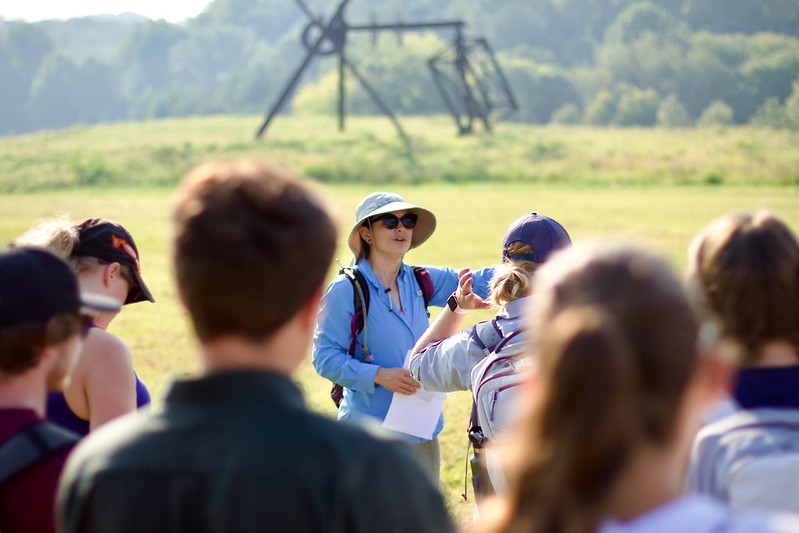Small-scale Science with Big Results: Using Nanotechnology to Improve Agricultural Sustainability

To feed a growing world population in the face of mounting environmental challenges, a team of scientists including Assistant Professor and Extension Specialist Khara Grieger sought to grow plants more sustainably. Enter nanotechnology, which refers to the ability to engineer and manipulate materials that are on the scale of approximately 100 nanometers (nm) or less, where 1 nm is 1-9 meters. At this very small scale, nanoscale materials can often exhibit new and novel properties. Published in Nature Nanotechnology in June, the authors including Grieger explain how nanotechnology can increase production efficiency and crop resilience and yields by utilizing nanocarriers, which can serve as efficient and precise delivery mechanisms for active agents, nutrients, and genetic material.
At the same time, Grieger and her colleagues are acutely aware of the myriad of risks that accompany emerging technologies, especially those in food and agriculture sectors. Grieger has been researching the potential risks of nanotechnology for more than 16 years and serves as a Project Director for USDA/NIFA grants that explore these risks as well as stakeholder perceptions of nanotechnology in food and agriculture sectors. Based on her research, she and her colleagues have documented that there is a complex mix of environmental, human health, and societal benefits as well as risks, and that stakeholder perceptions are largely based on these benefit-risk ratios and whether there is a “need” for the product. Further, her work has explored the role of responsible innovation in nanotechnology research and innovation in food and agriculture systems, and has formulated a list of best practices that scientists, researchers, and innovators can follow to help ensure their nano-agrifood product is aligned with responsible innovation practices.
Q: What are nanocarriers, and how are we currently using this technology?
A: Nanocarriers refer to the use of engineered nanoscale materials (such as nanoparticles) that have active agents (such as pesticides, herbicides, fertilizers) inside of them. The nanoparticles essentially serve as delivery vehicles for the active agents. In fact, our recent mRNA vaccines for COVID-19 were successful in part because of the use of nanoparticles for vaccine delivery!
While nanotechnology and the use of nanoparticles for drug/vaccine delivery has been actively explored and used in medicine (including the to treatment of cancer in patients), its use in plants as a delivery mechanism for agrochemicals is still in research and development phases for the most part. Today, there are many researchers who are exploring the use of nanotechnology as more efficient delivery mechanisms for agricultural crops through a range of scientific studies.
Q: Why is nanotechnology being considered as a solution to agricultural problems stemming from climate change and increased demand for food production?
A: Nanotechnology may offer more sustainable options to deliver agrochemicals compared to conventional delivery mechanisms. For example, the use of nano-pesticides and nano-fertilizers may offer a more efficient mechanism that is taken up by plants with less environmental run-off and off-target effects compared to conventional approaches.
In the case of agricultural fertilizers, and the use of phosphorus in particular, we know that only about 20% of the phosphorus that is applied in our food system as fertilizer ends up being incorporated into the human diet. The other 80% of the phosphorus is from losses through binding to soil, transfers to animal waste, and run-off from agriculture. And we know from other work conducted in our department through JoAnn Burkholder and colleagues, that excess phosphorus in the environment can lead to eutrophication, harmful algal blooms, and marine dead zones. Therefore, we clearly need to rely on a more efficient mechanism to deliver nutrients, including phosphorus, to crops with less environmental run-off, and therefore the idea is that nano-carriers may help in this way.
Q: Do the benefits outweigh the risks for utilizing nanocarriers in plants?
A: This is a key and defining question here. We know that there are numerous types of potential benefits as well as risks. Potential benefits include those to the environment (less agrochemical use, less run-off in the environment, less eutrophication and harmful algal blooms, fewer non-target organism effects), human health (less agrochemicals to be handled by farmers and farm workers), and economy and society (if the costs of nano-carriers are low enough to be competitive with the current systems, environmental benefits that positively effect society). At the same time, potential risks could involve environmental risks (ecotoxicolocal impacts, potential unknown or unforeseen environmental impacts to target or non-target organisms), human health risks (toxicolocal impacts, unknown or unforeseen health risks including to workers and consumers, and economic or societal risks (costs are too high, potential life cycle impacts). As mentioned, right now research is primarily within research and development stages- with numerous potential benefits that could be realized if we improve the technology/ies and are able to scale it up so it’s competitive in the open market.
Q: Is nanotechnology in agriculture environmentally sustainable?
A: This is also an important and key question and depends on a number of different aspects, including perceptions. As stated earlier, there are numerous potential benefits but also risks that need to be considered- all of which are context dependent (depending on different crops, nanocarrier applied, environments considered, stakeholder and consumer perceptions, regulations). In fact, in our USDA/NIFA-funded grant on the use of nanotechnology (and genetic engineering) in food/ag systems, we are conducting a stakeholder study to better understand different perceptions and views of nanotech-food/ag products and stakeholder recommendations to improve their sustainability. Results will be analyzed this fall.
Prior to this current grant, I also led a previous USDA/NIFA-funded grant on responsible innovation of nanotechnology in food/ag, where we conducted interviews and surveys with different stakeholders (including nanotech researchers/innovators) on their views of responsible innovation, views of nanotech in food/ag, and whether they were being responsibly innovated. Among other findings, we found that stakeholders perceived nano in ag products as more responsibly innovated compared to nano in food products, because of reasons of environmental, health, and safety considerations as well as whether the product met a societal need.
Q: How important is stakeholder perception for new technologies? How can scientists connect with stakeholders to alleviate misunderstanding and work cooperatively?
A: Stakeholder perceptions for new technologies in food/agriculture are very important. Food tends to be a very sensitive issue because it touches upon many different aspects that are important to people including health, views of the environment, views of technology, right to know what’s in the food supply, as well as having cultural significance, etc. So stakeholder perceptions of technologies in food/ag tend to be amplified compared to perceptions of those technologies in general.
From previous case studies, we know that perceptions of technologies in food/ag have influenced the use of genetic modification and genetic engineering in particular. In the case of nanotech, the field did not want to repeat what happened with the first generation of GMOs, where there was substantial public and consumer backlash in some cases, and therefore there were a lot of efforts made to avoid past mistakes. For this reason, there was an effort to dedicate funding towards environmental, health, and safety considerations as well as ethical, legal and societal implications (ELSI) right from the beginning of launching the nanotechnology field, starting in the early 2000’s.
Right now there are many new forms of genetic engineering that rely on gene editing (like CRISPR), such as the new gene edited mustard greens and the pursuit of seedless fruit (developed by RTP-based start-up, Pairwise). Because of this growth, there may be a renewed conversation about the role of genetic engineering in food/ag products, especially as our food and agriculture system increasingly confronts ways to deal with impacts of climate change while also producing abundant and safe food for a growing population, as well as to respond to consumer preferences.
In fact this is part of the reason why colleagues and I organized the Sustainable Agri-Food Technology Summit this past May – to discuss the role of emerging technologies in creating more sustainable food and agriculture systems. Assistant Professors Katie Sanders, Minliang Yang, and I co-led the workshop, with assistance from colleagues in the Genetic Engineering and Society (GES) Center. We had a total of 62 stakeholder participants from industry, academia, NGOs, and government who explored perspectives on the sustainability of novel agrifood technologies, shared real-world innovations, and identified collaborative opportunities for the future.
In terms of connecting scientists with different stakeholders, that is exactly what we are trying to do in our USDA/NIFA funded grants on nanotech (and genetic engineering). Often these connections happen through an organization that hosts different stakeholder workshops and events, like the US National Nanotechnology Initiative. For example, I’m a co-chair for the US-EU nanotechnology research communities focused on environmental, health, and safety aspects. We are regularly invited to participate in NNI events including the upcoming meeting in Switzerland in October. This work is an ongoing international initiative to improve nanotechnology research related to its environmental, health, and safety considerations.
To read the full paper published in Nanotechnology Nature, click here.
- Categories:


